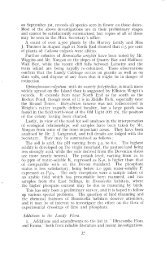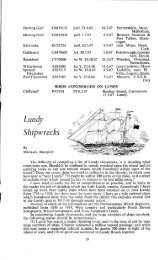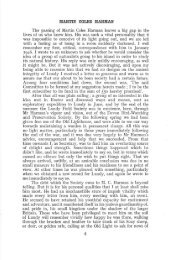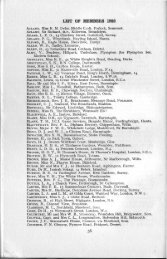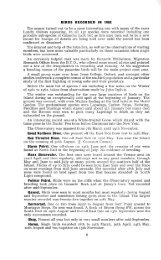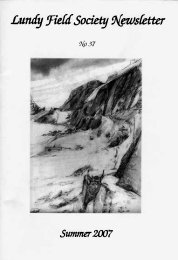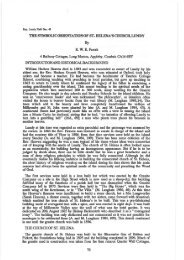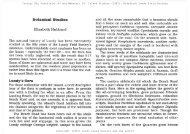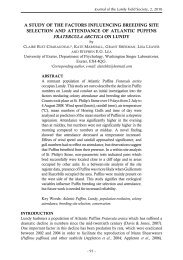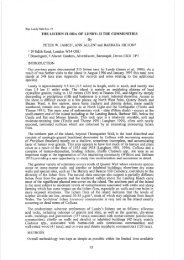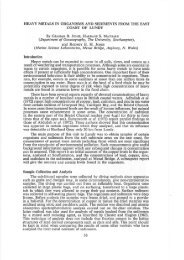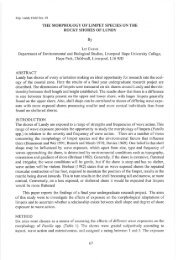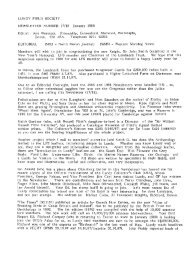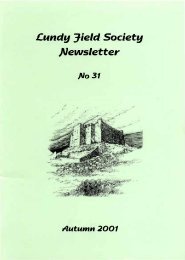THOMAS BENSON'S CONVICT SLAVES ON LUNDY
THOMAS BENSON'S CONVICT SLAVES ON LUNDY
THOMAS BENSON'S CONVICT SLAVES ON LUNDY
You also want an ePaper? Increase the reach of your titles
YUMPU automatically turns print PDFs into web optimized ePapers that Google loves.
Rep. Lundy Fld. Soc. 40<strong>THOMAS</strong> <strong>BENS<strong>ON</strong>'S</strong> <strong>C<strong>ON</strong>VICT</strong> <strong>SLAVES</strong> <strong>ON</strong> <strong>LUNDY</strong>ByA. F. LANGHAM17 Furzefield Road, Reigate, Surrey RH2 7HGThomas Benson, the son of a prominent Bideford merchant, became Sheriff ofDevon in 1746 and MP for Barnstaple soon afterwards. He traded successfully with theNew World, the ports of Bideford and Barnstaple becoming the focus for an annualimport of more than a million pounds weight of American tobacco. In 1747 he secured agovernment contract to transport convicts to work on plantations in Maryland andVirginia, thus providing a profitable return cargo for his vessels.In 1748 Benson leased Lundy Island from Lord Gower for the annual sum of £60.It provided the opportunity to offload tobacco from America, and repackage it intosmaller amounts for smuggling to the mainland. It also allowed him to offload theconvicts, having received the £20 per-head transportation fee, rather than having tocarry and feed them across the Atlantic. Convicts were housed in the castle keep andemployed building walls and enclosures. Other tasks may have included the repackagingof tobacco, either for smuggling or export.Below the keep but within the castle grounds is Benson's Cave, 17m long, Sm wideand Sm high, artificially quarried into the shale. It probably dates from the time of theCivil War when Thomas Bushell, a mining engineer, held the island for the King.The original cave was later enlarged and the presence of a capstain on an engravingby Grosse in 1775 suggests that goods of some considerable weight were beingtransported from the Landing Beach to and from the cave.During 1960 the author carried out a systematic survey of the walls and ceilinginside the cave and discovered thirty-eight inscriptions scratched or chiselled in a styleand typography quite distinct from modern graffiti (fig. I). By consulting the Exe1erQuarter Sessions and the Registers of Exeter Gaol (which list the names of prisonerssentenced and awaiting transportation), interesting similarities with the inscriptionswere revealed (tables I and 2). For example, it would seem that seventeen convictssentenced to transportation spent time on Lundy and that the dates of their sentencesfall into two groups, one in 1749, the other in 1752, suggesting perhaps that Bensonlanded two shiploads of convicts at a three-year interval. By comparing inscriptions withthe relevant historical sources, it may be suggested that seven or eight of the initials datefrom a 1749 passage to the island, and ten of the initials from a 1752 shipload. One mustremember, however, that the inscriptions are open to varying interpretation. Some ofthe convicts may never have inscribed their initials, most would have been illiterate andmay have had the inscriptions carved for them, while some may not have been familiarwith the shape or order of letters in their names. Thus some discrepancy between thenames in table 2 and the inscriptions in fig. I may be .explained.A further suggestion arises from the comparison between engravings and therecord of "seven or eight (of the convicts who) took the longboat belonging to the islandand made their escape to Hartland and were never heard of afterwards"(!). Thisoccurred in the summer of 1752 and may describe the escape of the seven or eight maleconvicts transported in 1949 and therefore known to have been slaves on the island for atleast three years.In July 1752 Benson made the mistake of allowing three of his houseguests to visitLundy, including Sir Thomas Gunson, Sheriff of Somerset. Benson remarked to theeffect that he had been contracted to remove the convicts from the kingdom and thatLundy was beyond recognised limits. Benson was, however, exposed and eventually fled50
the country. The fate of the remaining convicts is not known although presumably theywere removed and sent on to America to complete their seven year transportation order.By studying the engravings in Benson's Cave, it has been possible to providephysical evidence for the presence of convicts on Lundy as well as suggesting theiridentity. They provide graphic illustration for a period of Lundy's history littleunderstood beyond historic description and the limited availability of secondary sourcematerial.FOOTNOTE 1: from 'Journal of the time we spent on the island of Lundy in the years1752 and 1787' by a Gentleman. (In The Cave and Lundy Review, and Critical RevolvingLight, published at Barnstaple in 1824).fA tB1751 AB GB WSC1726 IC BCTC HD EF WH EH1780 PHSH (written 2 H) Df HH1750 WH1750 Wt DJJJ WL GM IM PM IN (written H1) EN1756fP MP HR IR 1751 IR WR 1751 MW1751fS 1709 (date may be 17~9 = 1749 or 1769) ss +1747 DWFigure 1: Inscriptions in Benson's Cave (NB. t = late Medieval form of J)51
1746 1747 1748 1749 1750 1751 1752 1753 1754EB MG MB RB TB RL CB RC JBPT PN JB MM MR JB RC SBJB JT MS EC ABJC MT cc JCTC JW AD TEAD JG CHMD AH WGHD JH JHJI DJ ELSK IM RNJL AM SPcs JM JPGPTPMRJRTSAYESDTssJVAWJWwwJYJWWYTable 1: Initials of convicts sentenced to transportation by Exeter Quarter Sessions1746-1754.1749 convictionsRichard BlackmoreJohn Buttall and!Joseph BucknoleJohn ClarkeThomas CookHenry DimontJohn InchSampson Kerswell1952 convictionsChristopher BanburyAnn HoppingDaniel JeffrysJane MonstephenAnn MartinMary Rice - the 'H' of the HR inscription is weak and could be MRMary Radcliff- could be represented by MP, HR, IR or WRThomas Sangum - could be represented by IS 1709 (his year of birth?)Sarah SpencerTable 2: Probable names of convicts on Lundy52



